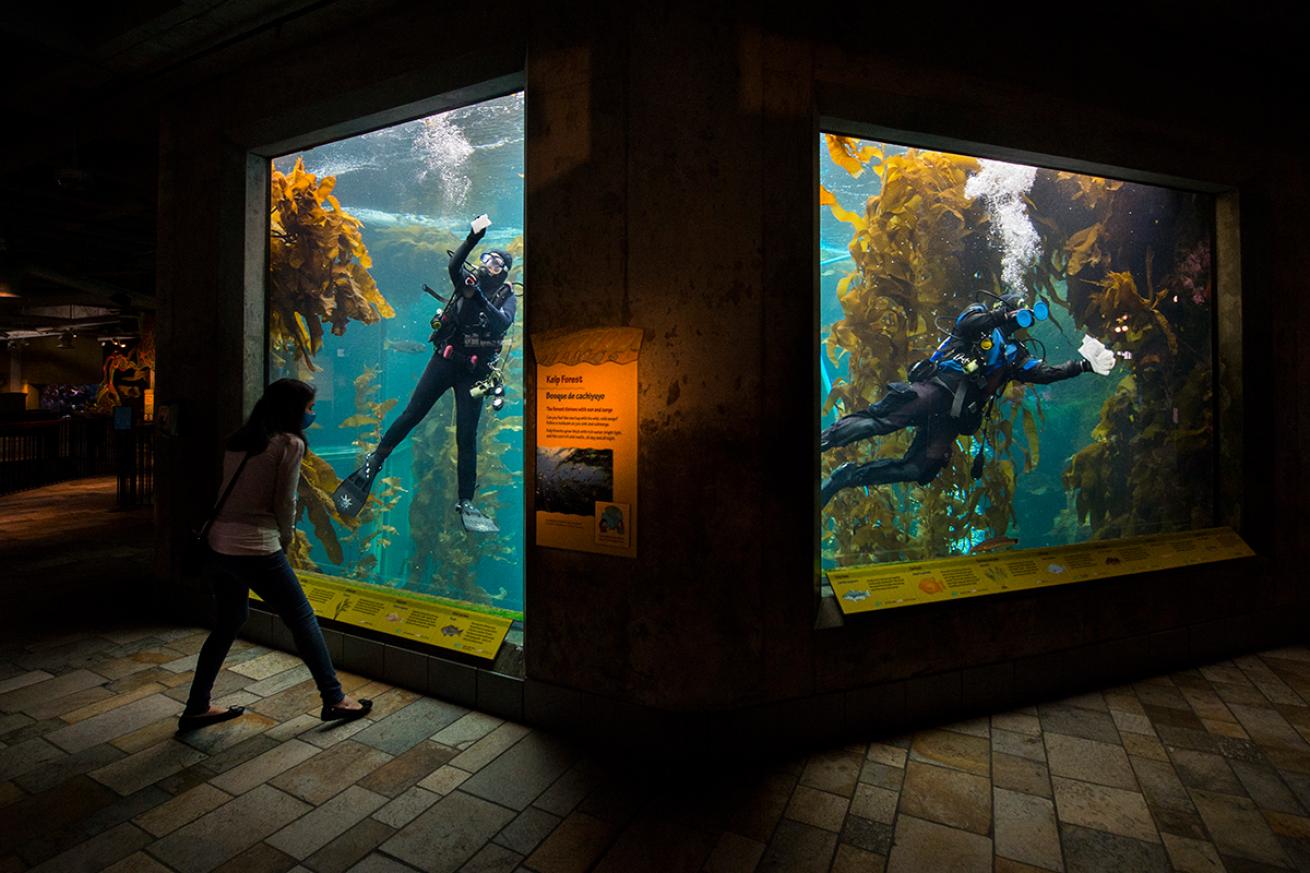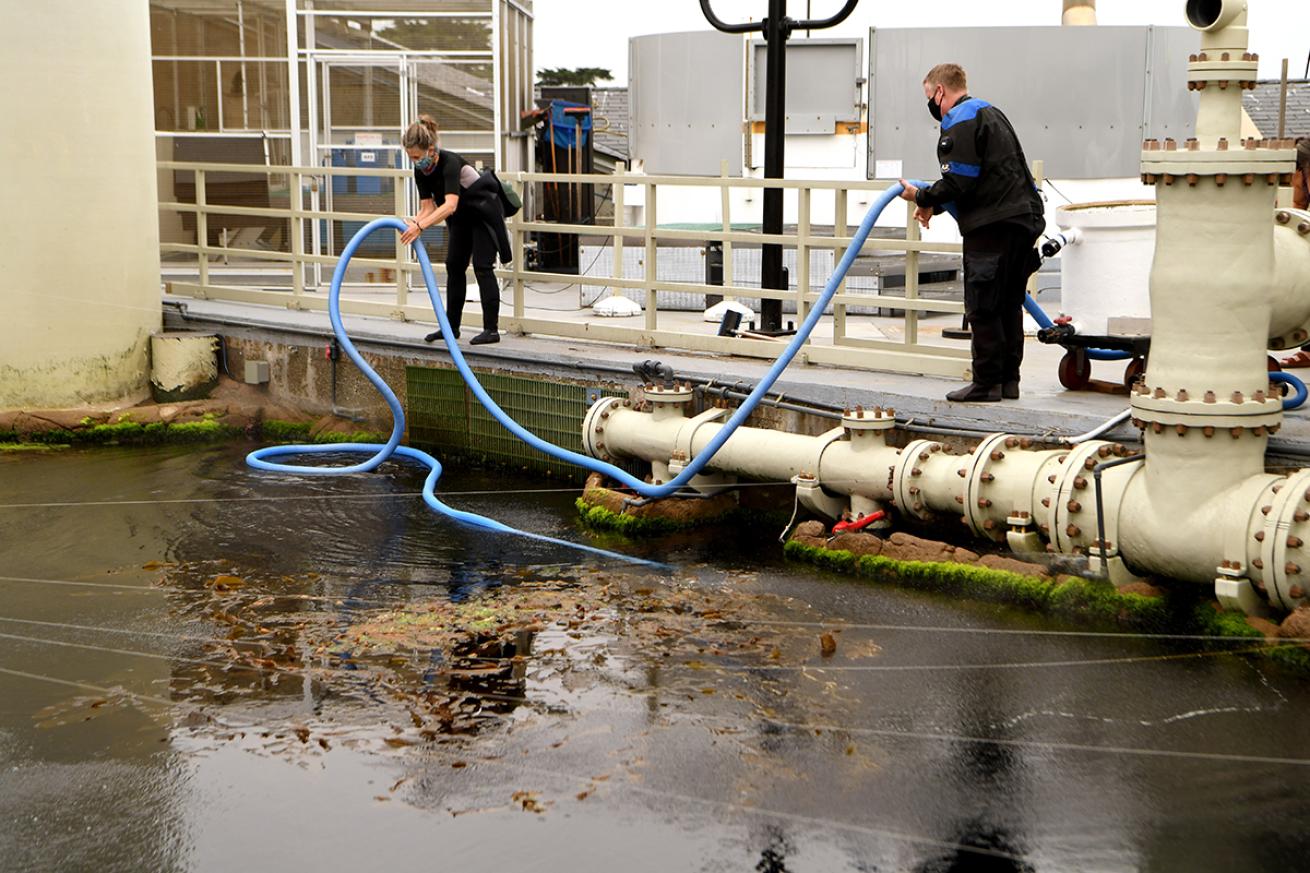Scuba Volunteers Still There for Monterey Bay Aquarium Animals Amid COVID

Bay Area News Group/Doug DuranVolunteer divers clean the inside of a kelp forest tank at Monterey Bay Aquarium.
The Monterey Bay Aquarium is world-renowned for its extraordinary collection of marine life, the enrapturing power of its exhibit spaces, and its commitment to educating the world on the wonders of the deep. A power behind the Aquarium’s allure is the depth and breadth of its thousands of volunteers who have long helped keep the well-greased wheels of the institution on track.
That was in the Before Times: pre-COVID. The virus put a wide crack in those tracks, closing the complex in March of last year, and causing the furloughing of many staff and volunteers. But the animals still need feeding and care, the tanks need maintenance—the show, albeit on a private scale, must go on.
“When we initially closed to the public, we halted all volunteer dive operations and only authorized staff dives providing essential animal care,” says Scott Chapman, a Dive Safety Officer at the Aquarium. “As we learned more about COVID, we modified our protocols and slowly brought volunteers back in.”
Twice-daily public presentations and four-days a week cleaning shifts are no more, but the onsite dive volunteers, pared from 105 to 43, still regularly help with maintenance and support. In Alice Bourget’s more than 25 years as a volunteer diver, she has dived in all the larger tanks, cleaned walls and windows, blown debris off reefs, helped collect sick animals, siphoned detritus and fed creatures.
Post-COVID, some things have changed. “The first step starts before we even leave home for a shift — we have to take our temperature, log that we are feeling fine, and have not been exposed to anyone who is infected,” says Bourget. “And it’s a bit tricky keeping a cloth mask on until we get to the water’s edge and put our regulators in our mouths, and buddy checks are now done from a distance of six feet,” she says.
Teams of no more than four divers are together at any one time, and cleanup is much more detailed and documented than before. “We essentially dissected every aspect of our dive operation and did our best to minimize potential vectors for disease transmission while still adhering to safe diving practices and occupational diving regulations,” says Chapman. “We have added layers of disinfection and operational controls to post-dive procedures. Dive Operations staff now apply a second round of disinfectant and then soak regulators in a sanitizing bath. Regulators and full-face masks are then isolated for at least 24 hours between use,” he says.

Bay Area News Group/Doug DuranDivers attend to equipment at the top of a kelp tank.
Bourget has noticed some post-shutdown differences in animal behavior. “Since the animals are not fed twice a day during the public-facing feeding shows, and although they’re fed just as much as before, they often get close and friendly when we get in, as they expect us to be bringing food,” she says. “Before COVID-19, I was primarily an evening diver, so I saw the fish quiet down for the night. Since there are no visitors, my team is now diving in the afternoons and everything is different—the light, the activities of the fish. For instance, I now see that the leopard sharks often take what appears to be a nap in the afternoon on the sandy bottom,” she says.
The virus has put the brakes on so many aspects of everyone’s lives, and the aquarium has felt its damaging constraint. “Our work is essential to maintaining the well-being of the animals under our care, so taking a pause on diving entirely was not an option,” says Chapman. “Thankfully, volunteers have returned and we’re now able to keep up with exhibit care needs. Overall, our primary focus remains the same—constantly assess risk, provide training and implement procedures and controls to minimize potential for diving-related injuries,” he says.
Diving in an aquarium that has no visitors does take a toll. “It’s sad because no one is there to appreciate all the wonderful exhibits,” says Bourget. “It’s also surreal to look out from the tank and down those long hallways without even seeing cleaning people hard at work,” she says.
For Chapman, a member of the Dive Office for 10 years, the responsibilities remain. All the Aquarium DSOs did a lot of research and adapted. “When the pandemic first hit, there was definitely a moment of uncertainty,” Chapman says. “How do we safely run a dive program during a pandemic? Diving is a passion for all of us, so we maintain a healthy respect for the virus,” he says.
No one knows when the Aquarium will open again, but Bourget has her hopes. “As much as I enjoy the relaxed pace of smaller teams and fewer people, I hope that before long the doors open, my team of ten gets to dive together, and the public once again experiences the wonder of the MBA. After all these years, I still get a thrill when I arrive for my shift and prepare to see my dive buddies and the many creatures in the exhibits—I want guests to experience the same feeling soon.”
Join the fun yourself by tuning into the Aquarium’s tank live cams, from jellyfish to sharks.










